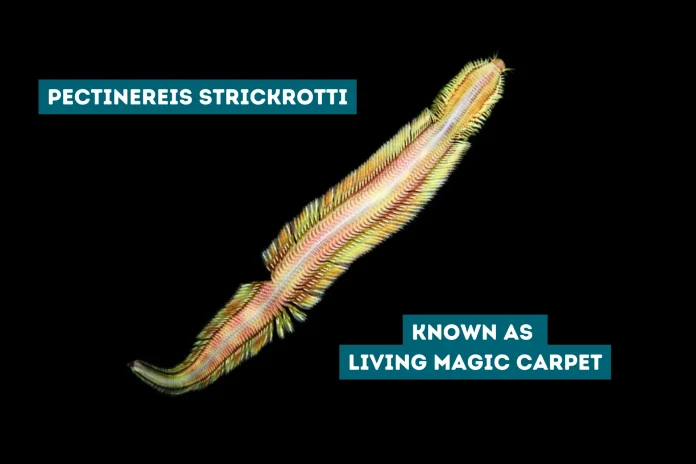The vast and mysterious depths of the ocean continue to surprise scientists with new and fascinating creatures. Researchers have recently discovered a species of new deep-sea worm floating near methane seeps off the coast of Costa Rica like a living magic carpet. This remarkable worm, Pectinereis strickrotti, has unique characteristics and adds to the growing list of previously unknown life forms in these unique ecosystems.
Collaboration Between Man and Machine
The discovery of Pectinereis strickrotti is a testament to the collaboration between human creativity and advanced technology. Marine biologist Greg Rouse and his colleagues have been studying methane seeps off Costa Rica since 2009. Using the human-occupied submersible Alvin, operated by the Woods Hole Oceanographic Institution, they have encountered a shocking number of species – an impressive 48 of them being entirely new to science.
Methane Seeps Helps Fueling Life in the Darkness
Methane seeps are areas on the seafloor where methane gas bubbles out from the sediment. Unlike hydrothermal vents, methane seeps are not exceptionally hot, but they share a reliance on chemical energy rather than sunlight to sustain life. Microbes capable of consuming methane form the food web base in these ecosystems. This food web supports various organisms, including mussels, crabs, and soft-bodied worms like Pectinereis strickrotti.
Encountering the “Living Magic Carpet”
The first encounter with Pectinereis strickrotti occurred in 2009 at a depth of approximately 1,000 meters. However, initial attempts to look at the worm were unsuccessful. It wasn’t until 2018 that the team successfully collected specimens using a specialized vacuum device on Alvin. Compared to a “living magic carpet” by Bruce Strickrott (the Alvin pilot after whom the worm is named), the worm’s graceful swimming motion further solidified its uniqueness.
Read more! Myth of Megalodon Real-Life Extinction Revealed in New Study
Pectinereis Strickrotti, a New Deep-Sea worm
Pectinereis strickrotti belongs to the ragworm family (Nereididae). These segmented worms typically inhabit shallower waters. However, it stands out by developing in the deep sea. Additionally, unlike most ragworms that absorb oxygen through their parapodia, Pectinereis strickrotti has specialized gill-covered parapodia for efficient oxygen intake. Notably, the male specimens collected had large spines on their tails, hinting at their specified role in reproduction. Living in complete darkness at 1,000 meters, Pectinereis strickrotti lacks eyesight. The worm likely relies on well-developed senses of smell and touch to navigate its environment. Although the exact diet of this unique worm remains unknown, its formidable jaws suggest it could feed on various food sources, ranging from bacteria to larger prey like other worms.
Its rosy coloration, observed under Alvin’s lights, is likely due to the color of its blood, as color has no bearing on its pitch-black habitat. The discovery of this worm highlights the vast amount of undiscovered life in the deep sea. This new species adds to the ever-growing list of over 48 new species found at Costa Rican methane seeps alone. Rouse emphasizes the need for continued exploration and protection of these unique deep-sea ecosystems.
Pectinereis strickrotti belongs to the ragworm family (Nereididae) and measures about 10 centimeters (4 inches) long. Ragworms are typically shallow-water dwellers, making Pectinereis strickrotti’s deep-sea habitat a notable difference. Additionally, most ragworms absorb oxygen through their parapodia, while Pectinereis strickrotti have true gills for improved gas exchange in the oxygen-limited environment.
The collected specimens revealed other unique features:
- Male-Dominated Sample: The team collected three male epitokes (sexually mature adults) and part of a female. This small sample size raises questions about the species’ population structure and sex ratio.
- Spiny Tails: The male specimens displayed large spines at the end of their tails. The precise function of these spines, possibly related to reproduction, remains unclear and requires further investigation.
- Life in Darkness: Due to the complete lack of sunlight at these depths, it is blind. It likely relies on a heightened sense of smell and touch to move in a dark environment.
Protecting the Deep Sea
The discovery of Pectinereis strickrotti highlights the vast unknown biodiversity in the deep sea. Rouse emphasizes the need for continued exploration and protection of these ecosystems. His team plans further expeditions later this year to methane seeps off the coasts of Alaska and Chile, aiming to uncover even more secrets beneath the ocean’s surface. This discovery of living magic carpet worms reminds us of the wonders that await us in the deep sea and the importance of safeguarding these fragile environments.



